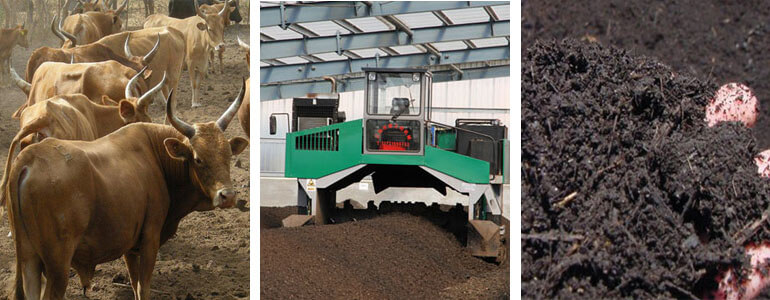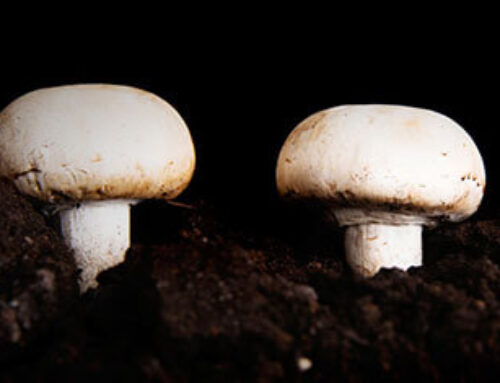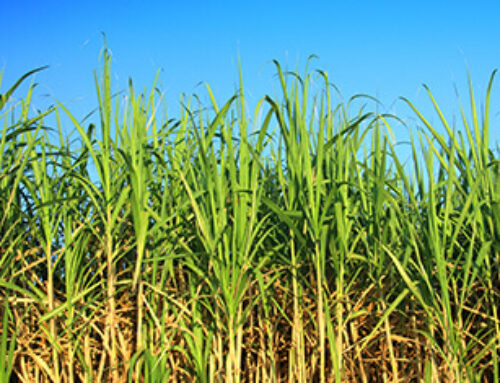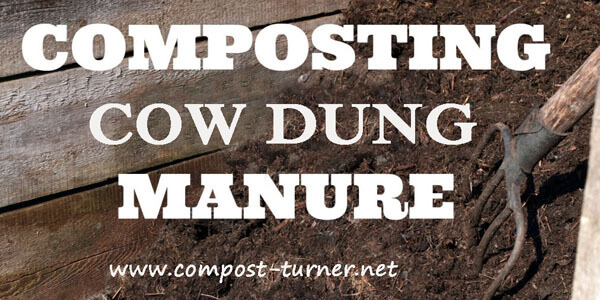
Cow Dung Ingredient
As an excellent biomass resource, cow dung also has many mineral elements (Table 1) and abundant nutrient substances (Table 2) as well as other feces of other livestock and poultry. Cow dung has a fine texture and more water content with slow decomposition and low calorific value, which belongs to slow-acting fertilizer. From the nutrient content perspective, the content of mineral elements and nutrient substances in cow dung is lower than the content of other livestock manure, its organic content is close to that of fowl manure, and only the crude fiber, crude ash, and nitrogen-free extract content are relatively higher. However, in virtue of the high yield and large total output, its total content of mineral elements and nutrient substances is also relatively larger. By using different processing technologies and crafts, especially via compost making technology and machine(compost turner), cow dung can be made into a variety of value-added products with harmlessness, resource and high efficiency, bringing favorable economic benefits and social benefits at the same time of preventing and controlling environmental pollution.
Mineral elements content of cow dung, pig manure, and fowl manure
Nutrient substance content of cow dung, pig manure, and fowl manure
Cow Dung Compost Making Technology & Machine
With various plant nutritional ingredients (like nitrogen, phosphorus, hummus, and so on), cattle manure is a valuable resource after the processing of composting fermentation, deodorization, and sterilization, processed into high-quality and efficient compost fertilizer/organic manure for cropland. Among the above livestock droppings, cattle dung has a close texture and high water content, but it has bad vent ability and slows composting, which needs strict control of each index of compost.
- Composting method is chosen: There are three major composting-making technologies for feces of livestock and poultry, including windows composting, slot type composting and cabin composting. When choosing a composting method, it is necessary to consider investment cost, composting efficiency, occupying area, operating expense, composting product quality, easy operation, easy maintenance, composting scale, composting environment, and so forth, so as to adopt the most suitable composting technology for poultry manure and environment condition.
- Composting fermentation conditions:
What needs to be noticed in the cow dung fermentation process:
Adjustment & control of fermentation conditions:
- Moisture control: Composting quality and efficiency is directly affected by materials’ water content whose main function is to dissolve organic matter and participate in the metabolism of microorganism and the adjustment of composting temperature. In general, just controlling the beginning water content at 50% – 60% can ensure the composting goes with a swing. When lower than forty percent, microorganism metabolism would be prevented, which makes the aerobic composting turn into anaerobic composting. When less than 15%, bacteria metabolism activity would stop universally, while when moisture is too high (over 70%), materials have a low void ratio and lack of air, adverse to aerobic microorganism growth and producing foul gas. Usually, the water content of cow dung is at 75%-80%, which means it’s very necessary to add additives with strong hygroscopicity to cattle manure so as to lower its moisture.
- Fermentation temperature: As one of the crucial conditions for normal fermentation composting, the temperature should be controlled and maintained appropriately. Different kinds of microorganism growth have various requirements for temperature, for example, the most suitable temperature for Mesophilic bacteria is 30-40 Celsius, and that of thermophile bacteria is 45-60 Celsius, while for high-temperature compost, it should be controlled at 55-65 Celsius. Composting is an exothermic process, without control, it would be up to 75-80 Celsius. If too high, it would excessively consume organic matter, lowering composting product quality. It has been found that composting temperature is at least 55 Celsius and lasts for over 5 days in order to kill the Coli bacillus and pathogenic bacteria. To control temperature, people often use pile-turning and forced ventilation in the production practice.
Carbon nitrogen ratio(C/N):C/N refers to the specific value between all carbon and all nitrogen of composting raw materials and filler mixture. During the process of composting, the carbon source is the energy source of microbial application while the nitrogen source is its nutrient substance. After consumption, carbon sources would turn into CO₂ and humus substance, and nitrogen would disappear in the form of ammonia gas or turn into nitrate or be assimilated by the organism. So the change of carbon and nitrogen is one of the basic features of composting. Due to the C/N range of microorganisms being 4-30, the C/N of organic matter should be better within this range. Neither too high nor too low are in favor of the growth and reproduction of aerobic bacteria. The suitable C/N in the process of cattle manure composting is 20-30:1 (30:1 is ideal).
- Ventilation: The major function of ventilation is to provide the necessary oxygen for aerobic microorganism growth and breeding, remove the redundant water content in the stockpile, adjust the temperature and reduce foul smell via controlling air demand. Research has shown that just 10% oxygen content can guarantee the need for microorganism metabolism. For successful cow dung composting, people should duly adopt a pile-turning method for ventilation or use a compost turner air-breather for aeration, adjust oxygen concentration and heat dissipation, and keep certain the gap among materials for aeration.
- pH value: Generally speaking, for composting, the most appropriate pH value is neutral or alkalescent because too high or too low would make compost processing trouble. During the practical production, if the pH value is too low, people can add 0.6kg-6.1kg of slaked lime or 0.8kg-8.5kg of calcium carbonate; on the contrary, if the pH value is too high, it would be better to add fresh green manure or grass to resolve organic acid, adjusting pH value to a suitable level.
During the whole process, the most important is fermentation composting, if fermentation is not enough complete, composting quality would be affected. As to the composting-making machine, we recommend a full hydraulic compost turner with large capacity, easy operation, high automation, and powerful turning, which has been widely applied to many European and American livestock breeding farms. As the advanced and professional turning equipment for cow manure, compost turner used for processing organic fertilizer can greatly enhance the combination of planting and breeding, ecological cycle, and green development, continuously improving and optimizing the agriculture ecosystem environment and promoting the level of agricultural sustainable development.
Applications of Cow Dung Compost
After composting, cow dung can be used as fertilizer or organic manure with the efficient use of organic matter, nitrogen, phosphorus, and some microelements, and what’s more, cow manure compost with a professional compost turner machine also has the advantages of low expense, big handling capacity, and good composting effect, etc.
Meanwhile, the aerobic high-temperature fermentation compost can digest lots of crop straw and other wastes, which can be not only used as fertilizer but also for producing edible fungus. Serving as fertilizer returned to land, flowers, or plants, composted cow dung can provide a mass of nutrient elements, promote the improvement of soil structure, and also act a significant role in soil water permeability and fertilizer retention capacity, and most importantly, play an important part in environmental pollution prevention and resources recycling. In addition, after the fermentation and compost of cow dung and crop straw according to a certain ratio, it can be used to produce edible fungus with very high nutritive value and economic value, fully utilizing the recycling and high-efficiency mode of biomass resources.
Extension Reading:
★ Pig manure composting technology
★ Chicken manure composting method
★ Importance role of compost turner in crop residue composting
★ Palm oil waste compost making process
Related Video:



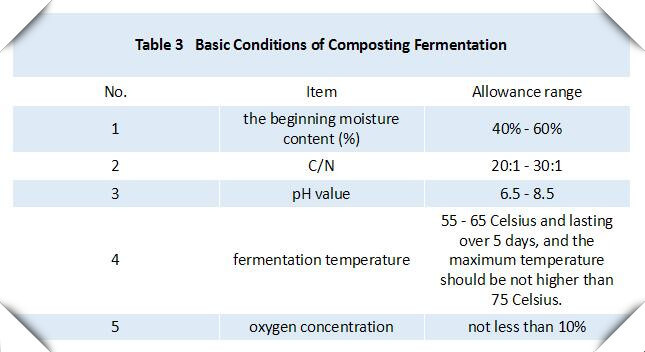
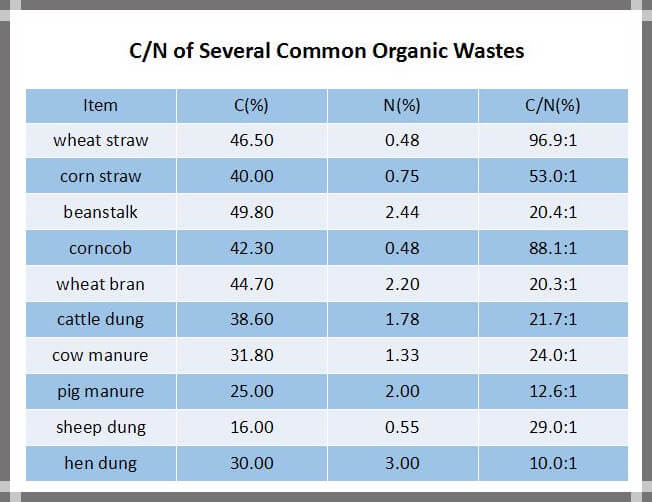 Carbon nitrogen ratio(C/N):C/N refers to the specific value between all carbon and all nitrogen of composting raw materials and filler mixture. During the process of composting, the carbon source is the energy source of microbial application while the nitrogen source is its nutrient substance. After consumption, carbon sources would turn into CO₂ and humus substance, and nitrogen would disappear in the form of ammonia gas or turn into nitrate or be assimilated by the organism. So the change of carbon and nitrogen is one of the basic features of composting. Due to the C/N range of microorganisms being 4-30, the C/N of organic matter should be better within this range. Neither too high nor too low are in favor of the growth and reproduction of aerobic bacteria. The suitable C/N in the process of cattle manure composting is 20-30:1 (30:1 is ideal).
Carbon nitrogen ratio(C/N):C/N refers to the specific value between all carbon and all nitrogen of composting raw materials and filler mixture. During the process of composting, the carbon source is the energy source of microbial application while the nitrogen source is its nutrient substance. After consumption, carbon sources would turn into CO₂ and humus substance, and nitrogen would disappear in the form of ammonia gas or turn into nitrate or be assimilated by the organism. So the change of carbon and nitrogen is one of the basic features of composting. Due to the C/N range of microorganisms being 4-30, the C/N of organic matter should be better within this range. Neither too high nor too low are in favor of the growth and reproduction of aerobic bacteria. The suitable C/N in the process of cattle manure composting is 20-30:1 (30:1 is ideal).